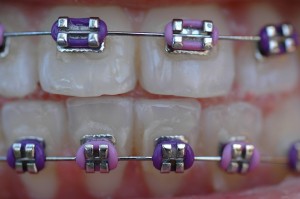April marks National Facial Protection Month
March 29th, 2013
 With spring here, many children, teens and adults will once again pick up the ball, bring the bat out of seasonal retirement, and lace up their cleats to hit the fields for the return of spring sports! April, which is only a few days away, is National Facial Protection Month, and during this time, we urge our young athletes to play it safe when out on the field. If you play sports and are undergoing orthodontic treatment, it’s important that you consult us for special precautions, such as wearing a mouth guard. A protective mouth guard is advised for playing spring sports such as baseball, soccer, lacrosse and others. Be sure, however, to avoid mouth guards that custom form to your teeth as these will resist any tooth movements we are trying to achieve.
With spring here, many children, teens and adults will once again pick up the ball, bring the bat out of seasonal retirement, and lace up their cleats to hit the fields for the return of spring sports! April, which is only a few days away, is National Facial Protection Month, and during this time, we urge our young athletes to play it safe when out on the field. If you play sports and are undergoing orthodontic treatment, it’s important that you consult us for special precautions, such as wearing a mouth guard. A protective mouth guard is advised for playing spring sports such as baseball, soccer, lacrosse and others. Be sure, however, to avoid mouth guards that custom form to your teeth as these will resist any tooth movements we are trying to achieve.
In case of any accident involving the face, check your mouth and the appliances immediately. If teeth are loosened or the appliances damaged, please schedule an appointment with our office. Only by using a mouth guard and other forms of facial protection can kids with and without braces avoid serious sports injuries. Please give us a call if you have any questions about mouth guards or your treatment.




 Millions of patients undergoing orthodontic treatment will not be smiling this holiday season, and not because they didn't get the gift they wanted. These are people whose teeth and/or braces fall victim to the hard, chewy, gummy or sticky holiday treats.
Millions of patients undergoing orthodontic treatment will not be smiling this holiday season, and not because they didn't get the gift they wanted. These are people whose teeth and/or braces fall victim to the hard, chewy, gummy or sticky holiday treats. Did you know there is a direct correlation between your bite and your overall health? When your teeth and jaws are not properly-aligned, it may affect your breathing, speech, and, in extreme cases, even affect the appearance of your face. As a result of malocclusion, also commonly referred to as “bad bite,” your teeth may become crooked, worn or protruded over time. Most people experience some degree of malocclusion, but it is generally not severe enough to require corrective measures. If your malocclusion is serious enough, however, orthodontic treatment may be necessary to correct the issue.
Did you know there is a direct correlation between your bite and your overall health? When your teeth and jaws are not properly-aligned, it may affect your breathing, speech, and, in extreme cases, even affect the appearance of your face. As a result of malocclusion, also commonly referred to as “bad bite,” your teeth may become crooked, worn or protruded over time. Most people experience some degree of malocclusion, but it is generally not severe enough to require corrective measures. If your malocclusion is serious enough, however, orthodontic treatment may be necessary to correct the issue.















 Absolutely not! Orthodontic treatment for adults is becoming more and more common. In fact, the number of adults getting braces has actually climbed 24 percent since 1996! More adults than ever are realizing that orthodontic treatment is not just for kids, and can help improve the aesthetics and health of a smile of any age! In a society where appearance matters and can help make the difference between getting a job or a promotion, adults are choosing wisely to invest in orthodontic treatment.
Absolutely not! Orthodontic treatment for adults is becoming more and more common. In fact, the number of adults getting braces has actually climbed 24 percent since 1996! More adults than ever are realizing that orthodontic treatment is not just for kids, and can help improve the aesthetics and health of a smile of any age! In a society where appearance matters and can help make the difference between getting a job or a promotion, adults are choosing wisely to invest in orthodontic treatment.




 Great question!
Great question!




